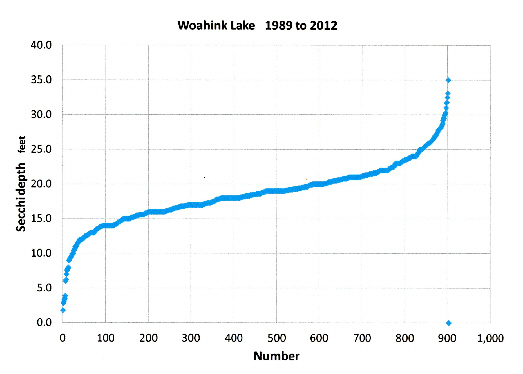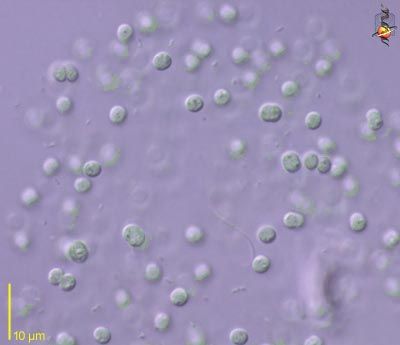|
Brief report on Woahink Lake:
Lake was sampled on 13 December 2012. Secchi depths were all between 10.6
and 9.6 feet. This was slightly better than on 2 November when they ranged
from 8.3 to 7.7 feet. Lake has cooled to around 11ºC from top to bottom
from about 14.4º C in November.
Attached are two figures. The first is all Secchi depth data (22years)
plotted from low to high. This allows us to see how frequently a given
value was observed. The point is that the Secchi depths are unusually
shallow now (and have been so since the cruise in late June).

The second is an Internet image of the organism identified to be the
cause of this reduction in Secchi depths, Anacystis marina. We are unable
to image this organism with our microscope because of its tiny size (see
scale on left axis). 10 µm is 0.01 mm.

In the same time interval, sampling from the Westlake dock (Siltcoos
Lake) showed Secchi depth decreasing from 6.9 to 4.6 feet. Fluorescence of
Chlorophyll a also increased significantly.
Stephen Hager, Water Tester - December
14, 2012
[
The "Woahink Lake" figure gives meaning to the depth data that has been collected.
The vertical scale is depth from 0.0 to 40.0 feet. The horizontal scale is numbers from 0 to 1,000.
What do readings of 8.3 and 7.7 mean? After finding the location of these points on the blue line one can compare these data with all prior readings.
These readings are not the shallowest recorded, but they are not good.
The big picture: The blue line shows that readings are increasingly shallow.
Woahink Lake pollution is increasing.
About µm:
The size of the organism in the picture, Anacystis marinam can be scaled from the vertical yellow line 10 µm in the lower left corner.
10 µm is 0.01 mm.
0.01 mm = 0.00039370078740157485 inch. 1 metre is equal to 39.3700787402 inches, or 1000 mm.
The organism needs food to survive. Remove the food and the Secchi depths should increase.]
|